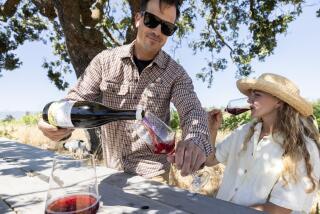Saving America’s Mother Vine
Reporting from Manteo, N.C. — It began as a fleck of brown on a leaf. Then several leaves curled and died. Soon the sickness spread.
The Mother Vine, believed to be the nation’s oldest cultivated grapevine, was in distress. Planted about 400 years ago, most likely by Croatan Indians or Sir Walter Raleigh’s settlers, the vine has survived hurricanes, nor’easters and suburbanization.
Now it had been brought low by that scourge of modernity, chemical weedkiller. A power company contractor removing brush from power poles in late May had accidentally sprayed the most famous planting along North Carolina’s Outer Banks.
Jack Wilson, an 84-year-old retiree, tried to save the Mother Vine. He’s been tending the plant since 1957, when he and his wife built a home on land where it grows at the edge of Roanoke Island, a few paces from Wilson’s front door on narrow, tree-lined Mother Vineyard Road.
The Mother Vine emerges from the sandy earth here above Roanoke Sound in several thick clusters of tough, woody roots. Its rambling green canopy — 32 feet wide and 120 feet long — is supported by an elaborate set of posts and arbors, some carved decades ago from locust trees.
Wilson pruned dead leaves and vines, only to watch the weedkiller outrace him, pumping poison from the ends of the vine toward the roots. The culprit was Garlon 3A, a Dow Chemical product. “A very nasty herbicide,” said Wilson’s 57-year-old son, John Wilson IV.
Wilson called for reinforcements.
Plant experts rushed in from the North Carolina Department of Agriculture. A viticulture specialist from North Carolina State University was dispatched to Manteo for consultation.
The power company, Dominion Virginia Power, was aghast. It did not care to be remembered as the corporate giant that killed the Mother Vine.
“When I was told a 400-year-old grape vine had been sprayed with herbicide, well, it wasn’t exactly what I wanted to hear,” said Chuck Penn, a Dominion spokesman. “We were distraught. You’re talking about an historical icon.”
Dominion accepted responsibility right away. “We were ready to face the music,” Penn said.
The company placed a hasty call to Lloyd Hipkins, a Virginia Tech weed scientist, who at that moment happened to be teaching a class of Dominion “commercial applicators.” Those would be the very contractors who spray and hack vegetation near power lines.
Hipkins drove straight to Manteo and prescribed a treatment: prune, water and fertilize.
“It looks like hell,” Hipkins said of the vine’s damaged section, “but the injury to the plant was really localized.”
All the out-of-town experts pruned more of the vine. They dosed it with fast-release fertilizer. They thinned the dense canopy to let in more light. And they watered.
For the next few weeks, Jack Wilson continued to nurture the plant. He watered the roots and coaxed along new green shoots. He didn’t want to lose the Mother Vine on his watch, not after 53 years.
Wilson was born and raised on the island. His family goes back 11 generations, to Adam Etheridge, an English settler who, for three pounds sterling a year in 1757, leased the land where the Mother Vine grew. Today, half the vine is on Wilson’s property, the rest spilling into a neighbor’s yard.
Last week, Wilson and his wife, Estelle, 80, crouched low under the sturdy wooden arbor that supports the vine’s canopy. They got a good look at the gnarled roots, some thick as steel cables. They saw fresh shoots and new tendrils tumbling down.
“I think she’s going to make it,” Jack said.
“I’m sure of it,” Estelle said.
Their son, who has helped nurse the vine through the crisis, surveyed its canopy and pronounced the Mother Vine on the mend.
“If she’s made it 350 years, or 400 years, I think if we keep taking care of her, she’ll survive,” John said. “She’s a tough old bird.”
Sara E. Spayd, the North Carolina State viticulture specialist, agrees the old vine appears to be fighting off the poison. “A little kick in the pants” with nitrogen fertilizer helped it outgrow the herbicide racing to its roots, she said.
Her prognosis?
“It’s a very large plant,” Spayd said. “It should recover and do well.”
That assessment came as a great relief to Rodney Blevins, a Dominion Power vice president who visited the Wilsons recently to check on the Mother Vine’s health. When Blevins heard about the spraying in late May, he called the family to apologize.
“We are deeply sorry for any harm that has been done to the Mother Vine,” Blevins said. “It’s an important cultural icon, not just locally but for the entire country.”
He said the company is working with its contractors to ensure they “don’t allow this to happen again.”
For more than half a century, Jack Wilson has lovingly pruned the Mother Vine to keep it from taking over his yard. It covered two acres when he arrived in 1957, but it has been trimmed back to about half an acre.
The Mother Vine produces sweet scuppernong grapes, a variety of muscadine. “In all the world the like abundance is not to be found,” two of Sir Walter Raleigh’s explorers wrote from Roanoke Island in 1584. The island’s grapes helped sustain Raleigh’s settlers before the 1587 Lost Colony mysteriously disappeared forever.
Thousands of cuttings have been taken from the vine, John Wilson said, helping sustain North Carolina’s growing wine industry. A health products company sells supplements made from Mother Vine grape pomace, touting the fruit’s antioxidants.
Jack Wilson said he’s been eating the amber grapes since he was a boy listening to tales of the vine from his grandfather, who was born in 1872. He gives away loads of grapes to townspeople and tourists who stop by to gaze at the famous vine. In bountiful summers, the amber grapes hang in clusters from the canopy.
“It’s a landmark from my childhood, and something that needed to be protected,” Wilson said.
One reminder of the Mother Vine’s near-death experience is a shriveled black tendril on a telephone pole at the front corner of Wilson’s yard. There’s also an ugly brown patch on Wilson’s front hedge left by the herbicide, and several severed branches of an old pecan tree, amputated after they were sprayed.
Wilson still checks on the vine several times a day, like a nurse hovering over a recovering patient.
“Dad didn’t sleep very well that first month,” his son said. “He’s sleeping better now.”
More to Read
Sign up for Essential California
The most important California stories and recommendations in your inbox every morning.
You may occasionally receive promotional content from the Los Angeles Times.











